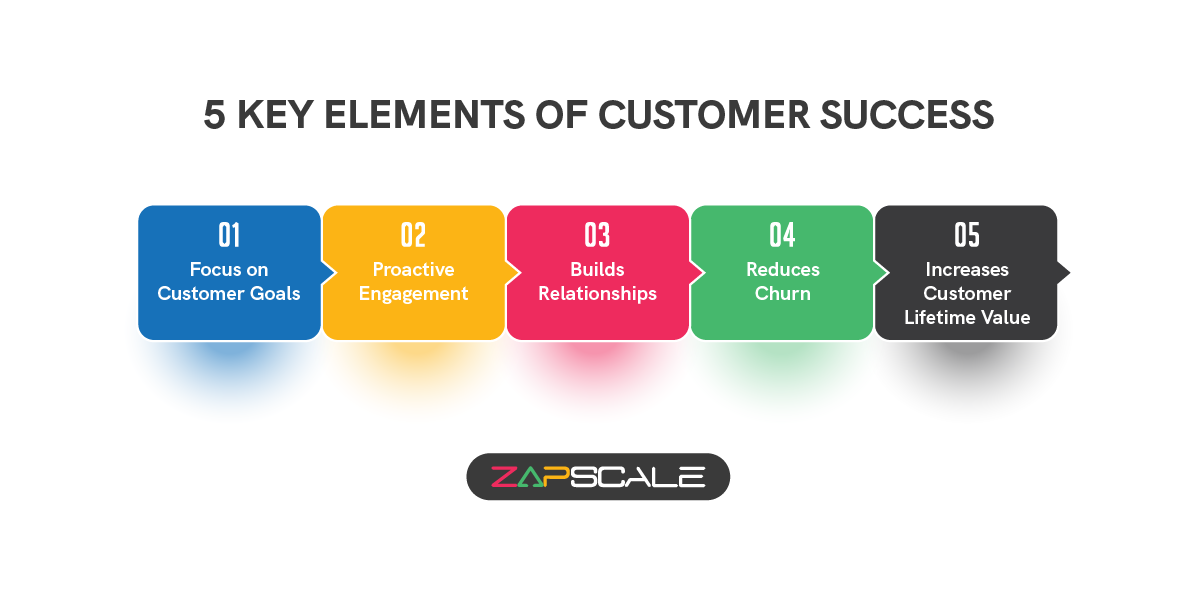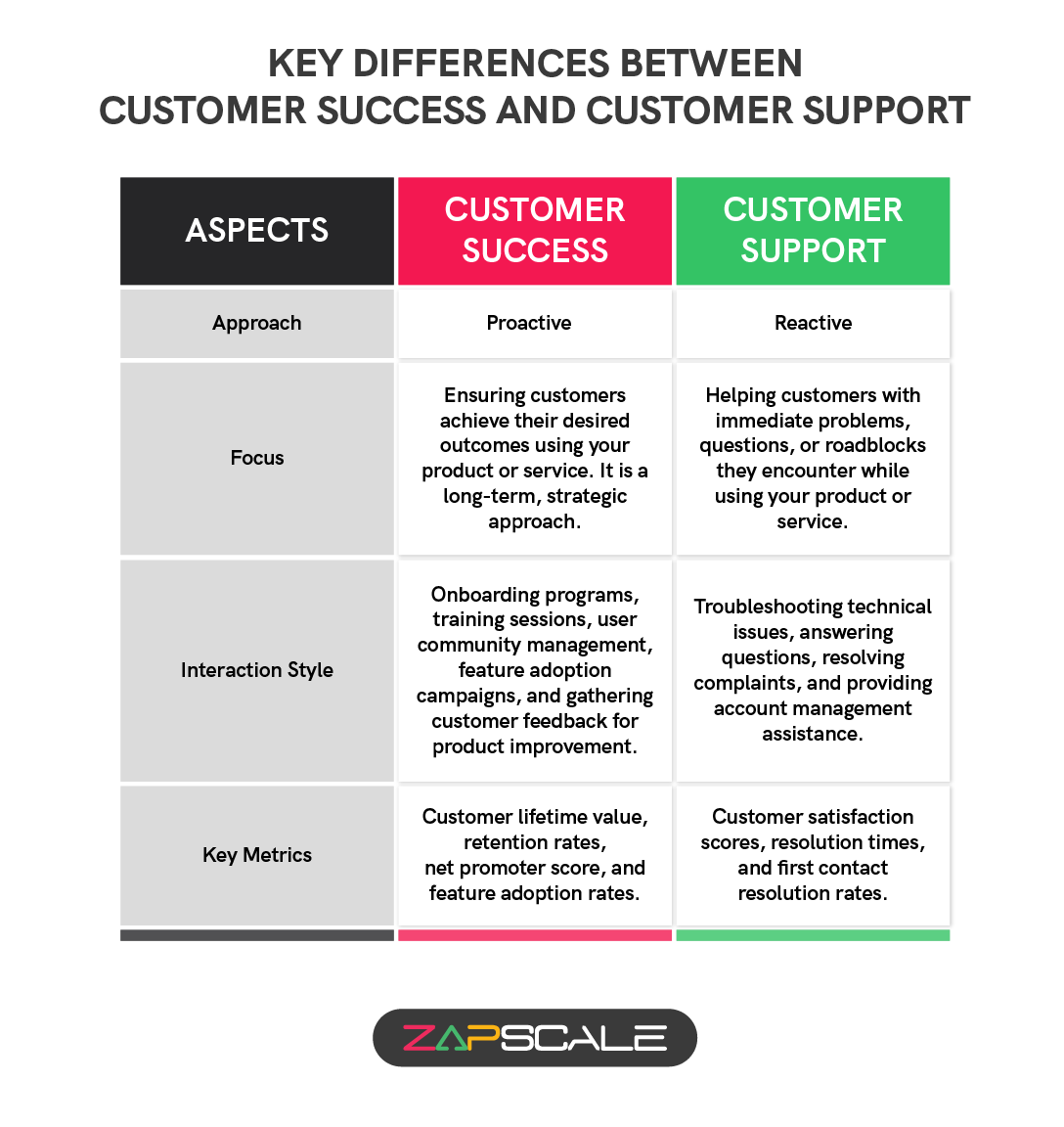CATEGORY > Customer Success Management
Customer Success v/s Customer Support: Key Differences

Introduction
In the fast-paced world of B2B SaaS, where complex solutions meet demanding customers, two forces play a critical role in a company's success: customer success and customer support.
These aren't interchangeable terms, though they both contribute to a single, overarching goal – ensuring your customers thrive with your product.
Imagine you've built a revolutionary project management tool. It has the potential to transform businesses, but if no one uses it effectively, or if users constantly run into roadblocks, that potential remains unrealized.
This is where customer success and customer support step in.
Customer success acts like a strategic guide, helping businesses leverage your tool to achieve their goals.
Customer support, on the other hand, is the emergency response team, ready to tackle any technical hurdles that might impede progress.
Let's delve deeper into how each function plays its part in this success story.
What Is Customer Success?
Customer success is a business philosophy centered around ensuring customers achieve their desired outcomes while using your product or service.
It's a shift from a purely transactional approach to a long-term, relationship-focused strategy. Here’s a breakdown of the core aspects of customer success:

1. Focus On Customer Goals
It’s not just about selling your product; it’s about understanding your customer’s specific needs and objectives.
How can your product help them achieve those goals?
2. Proactive Engagement
Customer success isn’t reactive (waiting for customers to come to you with problems). It’s proactive, anticipating customer needs and providing guidance throughout their journey.
3. Builds Relationships
Customer success teams build strong relationships with customers, becoming trusted advisors and advocates.
4. Maximizes Customer Value
It’s about ensuring customers get the most out of your product or service. This can involve training, ongoing support, and helping them discover advanced features.
5. Reduces Churn
By ensuring customer satisfaction and value, customer success strategies can significantly reduce customer churn, the rate at which customers abandon your product.
6. Increases Customer Lifetime Value
Happy customers who see value in your product are more likely to stick around for the long term, increasing their overall value to your business.
The Benefits Of Customer Success
Here are some key benefits of implementing a customer success strategy:
1. Increased Revenue
Satisfied customers are more likely to renew subscriptions, purchase additional products, and become brand advocates.
2. Reduced Costs
Customer success can lower customer acquisition costs by improving retention rates.
3. Improved Product Development
Customer feedback gathered through customer success efforts can inform product development and ensure your offering stays relevant to customer needs.
4. Stronger Brand Reputation
A focus on customer success fosters positive customer experiences, leading to a stronger brand reputation and increased customer loyalty.
In conclusion, customer success is a strategic approach to building long-term, mutually beneficial relationships with your customers.
By prioritizing customer goals and ensuring they achieve value, you can cultivate a loyal customer base and fuel sustainable growth for your business.
What Is Customer Support?
Customer support is the frontline of a company's service efforts. It's the team or system dedicated to assisting customers with questions, issues, or roadblocks they encounter while using a product or service.
Think of it as a helping hand for your customers, ensuring they have a smooth experience and can get the most out of what you offer.
Here are some key aspects of customer support:
1. Reactive vs. Proactive
Customer support is typically reactive. Customers reach out to the support team when they have a problem, question, or need help using a feature.
2. Communication Channels
Support teams can interact with customers through various channels like phone calls, email, live chat, social media, or even self-service options like FAQs or knowledge bases.
3. Resolving Issues
A core function of customer support is troubleshooting and problem-solving. The support team works to identify and address customer issues efficiently and effectively.
4. Building Trust
Through positive interactions and helpful resolutions, customer support representatives can build trust and rapport with customers, fostering a positive brand perception.
The Importance Of Customer Support
Here's why customer support is crucial for any business:
1. Increased Customer Satisfaction
Prompt and helpful customer support can significantly improve customer satisfaction, leading to higher retention rates.
2. Reduced Churn
When customers get the support they need, they're less likely to abandon your product or service.
3. Improved Brand Image
Positive customer support interactions can enhance your brand image and build customer loyalty.
4. Valuable Customer Feedback
Customer support interactions can be a goldmine for customer feedback, helping you identify areas for improvement in your product or service.
In conclusion, customer support is an essential function for any business. By providing efficient, helpful, and friendly support, you can cultivate a positive customer experience, build trust, and foster long-term customer relationships.
Key Difference Between Customer Success And Customer Support
The key difference between customer success and customer support lies in their approach and focus.
Here's a breakdown to clarify:

Here's an analogy to illustrate the difference:
Imagine you're running a gym.
1. Customer Success
The customer success team acts like a personal trainer. They create personalized workout plans, motivate you to reach your fitness goals, and teach you how to use the equipment effectively.
2. Customer Support
The customer support team is like the front desk staff. They answer your questions about gym memberships, troubleshoot issues with equipment malfunction, and help you navigate the gym facilities.
Conclusion
In essence, customer success is about building a long-term, successful partnership with your customer. Customer support is about providing immediate assistance and ensuring a smooth customer experience.
Both functions are crucial for a healthy business.
Customer success helps retain happy, productive customers who contribute to your long-term growth. Customer support ensures customer satisfaction and prevents frustration that could lead to churn.
Ideally, these two teams work together to create a seamless customer journey.
ABOUT THE AUTHOR
Popular from Customer Success Management
Quality Content,
Straight To Your Inbox!
Subscribe for the latest blogs, podcasts, webinars, and events!

Write a Blog
If you have experience in CS and
a flair for writing, we’d love to
feature you.
Write to us on
hello@zapscale.com





